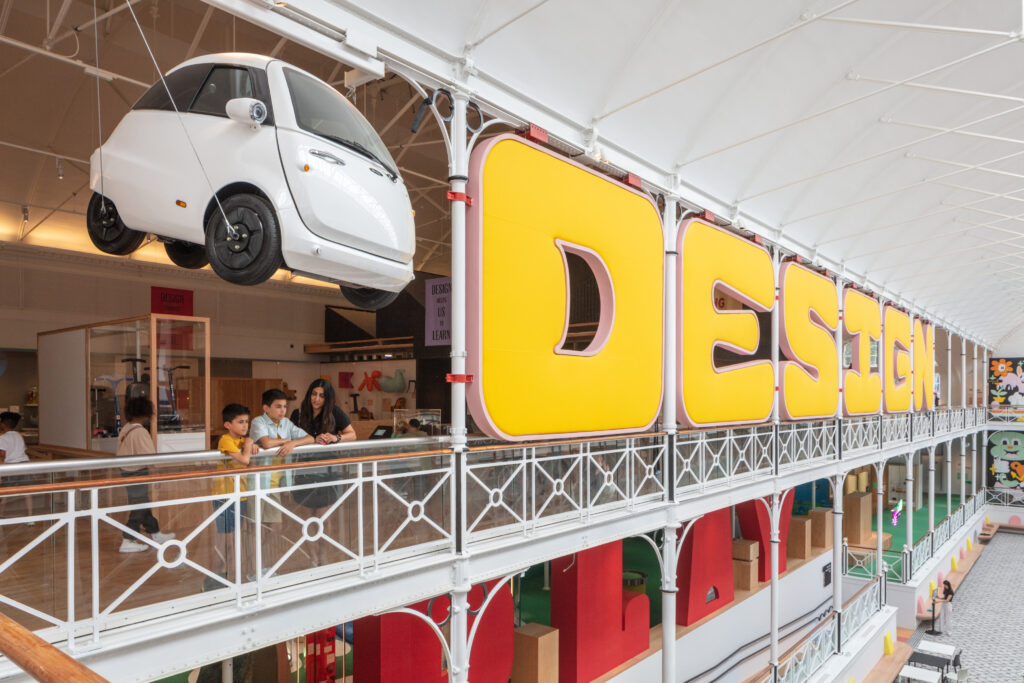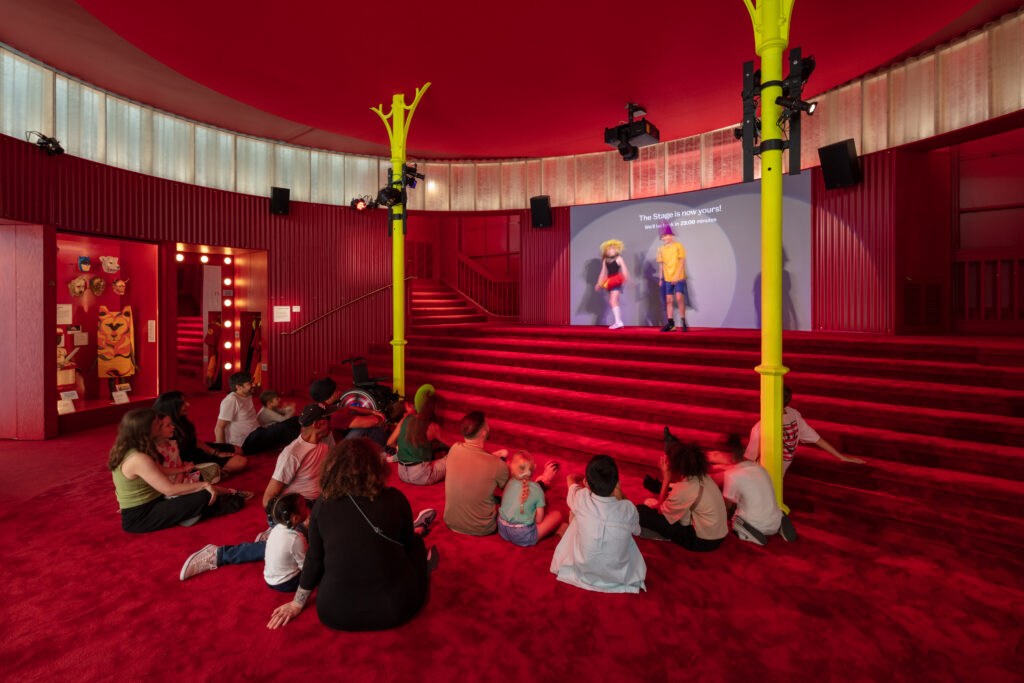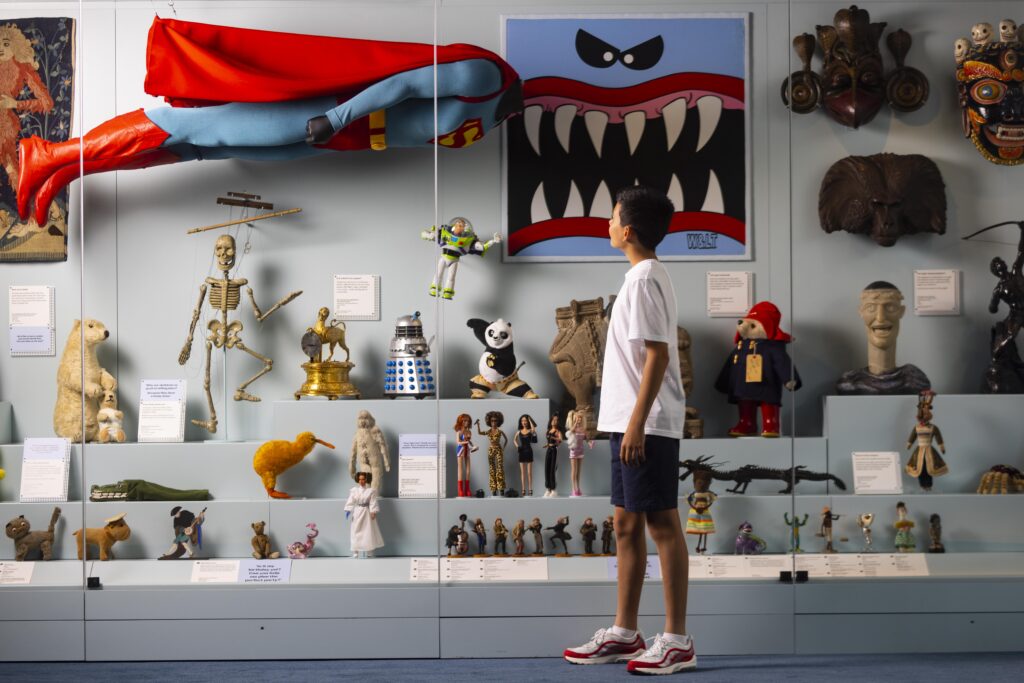Child’s play | Young V&A, London
“I love it so much I never want to leave,” my daughter said to me nearing the end of our visit. With two young children, I’m an enthusiastic consumer of London’s museum offerings for kids, and was naturally excited when the Victoria and Albert Museum’s (V&A) venue formerly known as the Museum of Childhood reopened this summer with its new name, Young V&A.
So often, the offerings of this city’s cultural establishments are aimed at the over-fives, but things have just got better. Indeed, what a triumphant achievement the museum’s transformation has been. It is noisy, colourful and fun – everything a museum for children should be.
On arriving you’re greeted with a large, airy atrium filled with natural light thanks to a glass ceiling. Huge letters in bright colours spell out Design, Play and Imagine, indicating the three new galleries and boldly setting out the museum’s mission. The galleries are designed with different age groups in mind, from babies to teens, but my children loved exploring all three.

We started with Play, aimed at younger visitors. Large, bright cases with white backdrops and uninterrupted sheets of glass show off colourful toys. The floor-level cabinets were perfect for my two-year-old to get close to the exhibits.
Interactive displays, designed to encourage collaboration, are peppered throughout this gallery. In the foam-brick construction area, my four year-old said to my youngest: “Let’s go and make some new friends,” as they went off to start creating.
Play even features a “mini museum” for under-threes – refreshing when older children often dominate play areas. A sensory delight, with texture, colour and pattern in abundance, the surroundings take their cue from the objects on display.
A fluffy green Prada top and sparkly silver boots are shown off in floor-level cases, perfect for crawling babies and toddlers. And why not? The beauty and creative genius of high fashion shouldn’t be reserved for adults alone.
We loved Imagine, a series of spaces to inspire creativity through performance, storytelling, imagination and community.
My four year-old’s imagination was especially sparked by Story Machine, a brilliant space reminiscent of Nick Sharratt’s book You Choose (a favourite in our house), in which children can create their own adventures using collection objects and prompts such as “where are you going to go?” and “how are you going to get there?”.
Both children were struck by the films in the sumptuous red-carpeted stage area that showcased performance in its many forms, from a magical dance piece by Akram Khan Company, to drag, puppetry and fashion.

Upstairs, the Design space is packed with examples of innovative, sustainable and environmentally conscious design. Although it was pitched at older children, my two still enjoyed exploring the inspiring displays. Who knew that old sandpit toys could be remade into furniture?
Accessible to everyone
Diversity and inclusion are evident throughout the museum, from disabled Barbie dolls and autism-awareness trainers to the diversity of the makers. It’s noticeable, too, that there is no dumbing down for children, with reproductions of art masterpieces and objects created by leading designers sitting comfortably alongside the toys.

In the galleries, the interpretation is cleverly pitched at different levels, so all ages can enjoy the exhibits. This is especially true in Play, where the displays are peppered with a mix of informative snippets, rhymes, poetry and questions. Labels are kept short, which is ideal for early readers and prompts visitors to look and imagine, rather than be dictated to.
The museum is a visual feast with each space a joyous mix of colour, texture and pattern. You can tell that children were consulted in the museum’s design process and it is all the better for it. Playful wayfinding signage in the form of giant hands clearly signposts the galleries, while introductory panels that mimic giant pegboards add to the spectacle.
On to the more practical elements of our visit. On arrival, there is plenty of buggy parking, with more at the far end of the museum. The galleries are spacious with room for children to run around, which they did, along with space for buggies and wheelchair users. There are two lifts with enough space to comfortably fit two buggies or a wheelchair.
Designing with and for children
For Young V&A, both teams of architects – De Matos Ryan and Agents of Change – placed the needs and interests of children at the heart of the process from the beginning.
De Matos Ryan ran early sessions with children, families and school groups to think in open ways about how they wanted to encounter and move around the building. This is where the challenge to build the world’s most joyful museum began.
We understood that the space needed to allow for a huge range of needs and behaviours – informal without losing its impressive beauty, calm without losing its sense of surprise and excitement.
Natural light was incredibly important as children wanted more light and colour. We took a bold decision to reopen the rooflights, which unlocked a whole new way of thinking about the space as an active, communal area.
Agents of Change pushed this forward, working with children of all ages to consider how finishes and colour make the space more comfortable and friendly, while still celebrating the Victorian engineering.
We set up a studio in the museum with a viewing area for children to watch the design process. When it wasn’t in use they could look at the model on their own.
There was also a space where we tested display and activity ideas and let children propose new ways of showing objects.
At the museum’s heart is an ambition to generate new connections, not only between visitors and objects, but between visitors, to encourage them to play and create together in a safe, welcoming environment.
Philippa Simpson is the director of design, estate and public programme for the Victoria and Albert Museum
There is ample seating around the museum for exhausted parents and children, and some of it is away from the galleries for those needing a quiet moment or space to feed a baby. The main atrium is lined with bench seating. There were quite a few families eating their packed lunch here, but we opted for the cafe instead.
The cafe felt crowded, with tables and chairs tightly packed together. Some spacing of the tables could be beneficial here, as buggy and wheelchair users could have difficulty reaching the cafe counter.
The catering itself was fine. My sandwich was a little on the dry side and the coffee mediocre, but the kids’ lunchboxes were reasonably priced – for London – at £6.

There is a microwave and bottle-warming station for feeding little ones. There could be more highchairs, but they are well made with trays that fit under the tables – a nice touch that allows you to bring youngsters closer.
The bare necessities
As I have a child who is still in nappies, good baby-changing facilities are a must. Baby-changing is available in women’s and men’s toilets – bravo. The toilets included low loos for small children, which my four-year-old appreciated.
Accessible loos with baby-changing tables and a Changing Places toilet are also available, although I noted these were locked, which would mean finding a staff member – slightly frustrating.

For those needing a quiet space or to privately breastfeed, there is a designated room on the lower ground floor. Access information is stated on the museum’s website, laid out in a clear, concise way. There were also lots of staff around, so plenty of help on hand should you need it.
Both adults and children cannot fail to be entertained and inspired here. While my two children were slumped on a sofa exhausted, my 46-year-old partner was still busy taking photographs of Masters of the Universe figurines, reminiscing about toys from his childhood.
In short, the Young V&A is a riotous, colourful and loud celebration of childhood. We will be back.
Hannah Thomas is the marketing and communications manager at the Foundling Museum, London